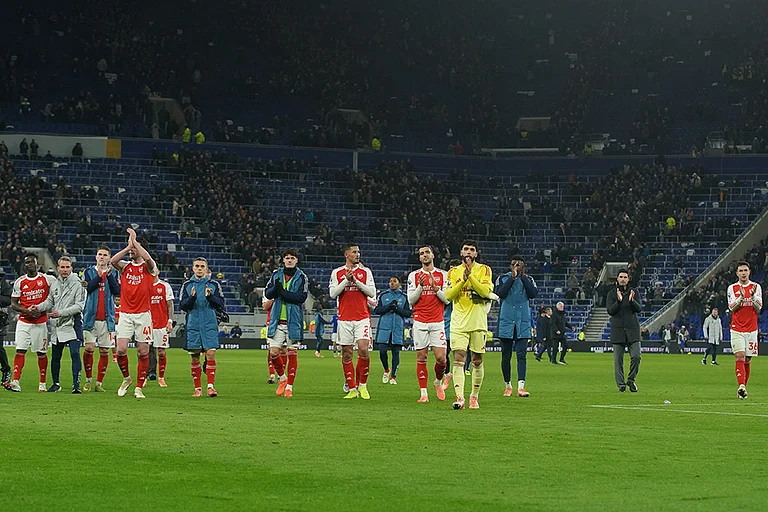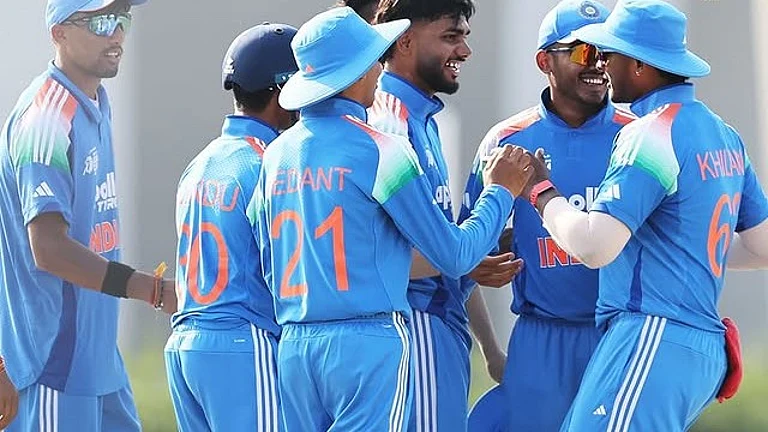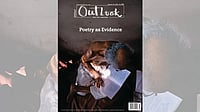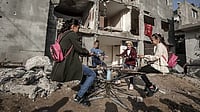Among all spiritual gurus, Outlook chose Mata Amritanandamayi Devi for this interview because she is unlike others in many respects. She is from a fishing village on the Kollam coast in Kerala, one of the few which are still Hindu, speaks only Malayalam and is a symbol of a person’s journey from vulnerability to veneration. As an individual, she is the most effective preacher in God’s own land of holy men and women. And her influence is spread across charity, education, healthcare, media and entertainment. Excerpts from an interview:
All these years, you have been trying to bring devotees closer to God. Who needs God? Is God just a crutch for those who do not have mental strength?
Everyone needs God. Some realise it, some don’t. In reality, the path to God is only meant for people with tremendous mental strength. This is because controlling one’s mind is a fundamental aspect of spirituality. It is impossible for someone who is weak-minded to control and sublimate his or her desires, thoughts and emotions. Only the courageous can do that. This question, in fact, should be answered with another question: “Are those who claim God is just a crutch for the mentally weak themselves mentally strong?” Do they have the right to make this claim? In fact, such people themselves are slaves to mental weaknesses, petty thoughts and desires. They falter when faced with even minor challenges. So, you cannot really call them strong.
So, they are speaking out of ego?
No, not like that! People who claim to be mentally strong seem to possess mental strength, but history is replete with examples of such people ultimately seeking refuge in God’s power. So, it’s not necessarily ego, but just that they are ignorant about the real concept of God. This world itself is God’s visible form; the universe is God. Everything we see in this creation is a manifestation of God consciousness. The creation and the creator are not two; they are one. The mind needs to become firmly rooted in this awareness, and this has to become one’s worldview. Then we can realise the eternal truth that God is not distant or external—that, on the contrary, “I am God.” To me, this is true faith—not trying to fulfil petty desires by chanting God’s names, performing pujas or visiting temples.
So, is lack of faith their crutch?
In fact, everything is an act of faith. Even to take one step forward, we have to have faith. We sleep, sit, walk, come and go—all on the basis of faith. Strength is needed to face the world. Those who know how to swim in the ocean enjoy playing in the waves in which others may drown. A spiritual outlook gives people strength to face adverse situations. That is why it is said Lord Krishna’s life was one long outburst of laughter. He had the attitude of acceptance. He knew what was going to happen and simply watched it unfold, as a witness.

As a child, Amma was told not to pluck a single extra leaf
Do stronger people become rationalists and atheists?
Not necessarily. Real rationalism should help us understand an object’s true nature. From this perspective, it is easy to accept that there is a Supreme Power beyond this incredibly limited body and mind. Modern science says every atom in the universe is connected to each other. Not being able to accept this is only ego. Ego is a destructive force that will only create harm for the world.
Life is a combination of logic and mystery, with more space perhaps for mystery than logic. This mystery is God. In fact, what most people think of as mental strength (mano-sakti) is completely different from self-strength (atma-sakti). Atma-sakti, in fact, is true mental strength. Those who have real mental strength will have trust in the Inner Self, in the infinite power of the Self. The so-called mental strength of those who believe only in their own mind soon dissipates. At some point in life, such people will collapse. But when we have faith that “I am a part of the Infinite Power; I am that power,” this breakdown will not happen. Such people are happy and content in all circumstances. It is like placing one’s faith in the electricity—the totality of it—rather than in a light bulb and the limited light it emanates.
How does Amma lead devotees to God?
I awaken this awareness in them, but there is a particular way of doing it. When we visit a new place, it is easier if a native person can guide us. When we try to learn a foreign language, it is easier under the guidance of a native speaker. That is the kind of support I give them—assuming the role of a spiritual guide. A seed needs the proper climatic conditions to sprout and grow. An apple seed will not sprout where it is hot. Date palms do not sprout where it is cold. For the growth of a spiritual aspirant, the guru’s presence is the right climate. It is like a song to which you can only remember the first line. The guru picks up the line and sings the entire song. It is like giving purified water to those who have been drinking impure water.
God is not separate from you. He is within every individual. He is the consciousness and life-force in each individual. The waves in the ocean as well as the ocean are made up of water alone. God is Infinity itself, and individual beings parts of that infinity. When you go to a jewellery shop, you may see varying sizes and shapes of earrings, necklaces, rings, bangles etc. If someone asks you then, “Where is the gold?” you will answer, “Here, every piece of jewellery you see here is pervaded by gold.” Similarly, the infinite power that manifests in Him, you, me and in this universe of sentient and insentient beings—in all names and forms—is God. So, if you ask, “Where is God?” the answer can be nothing but “Here! Everything is God. All that you see around you is God. There is nothing other than God.”
My concept of God is like the seed of a banyan tree. It is from the seed that the tree trunk, the leaves, the roots, the flower and the fruit are all formed. The seed is not like the tree trunk. The tree trunk is not like the flower. The flower is not like the fruit. The fruit is not like the leaves. Even each leaf is different. Yet, the essence of the seed is in each one of them. Similarly, God is the consciousness that pervades and fills everything to the brim.
Some may ask, “Then, where is the consciousness in a dead body?” If a fan has stopped functioning, it doesn’t mean electricity has ceased to exist. Electricity still exists; it’s just the device that has stopped functioning. Likewise, pure consciousness has neither end nor beginning. It is ever-present.
How does God respond to Amma? What is the nature of your communion with God?
Questions, answers, conversation, discussion—all these exist between two individuals. But God is not an individual, a personality or a particular form that sits on a golden throne beyond the sky and passes judgement. God is pure consciousness. This infinite universe is God. Once we realise that the individual and the infinite universe are one, then there is no place for conversation, questions or answers. There is only oneness. It is like realising that the truth is not the clouds but the sky, or that the ocean and the waves are one. The Self is not like a battery that needs to be charged; it is the very source of power—electricity itself.
Millions of people come to Amma. Why do they come?
Even if someone has everything else, the two things they crave most are love and peace. Perhaps, they are finding that here. Man takes birth, lives and acts only to attain this love and happiness, but there is a dearth of love in this world. This lack of love is the worst deprivation in our world, causing 90 per cent of the problems we face.
People often say that when they come to you, you greet them with a tight hug. Then they either break down in tears like a child or lose consciousness. What is this experience?
However old or young—whatever be their profession—in every person there is a small childlike heart within crying out for innocent love. In Amma’s presence, that innocence awakens. Perhaps this is what makes them cry. Compared to a mahatma, who is like a transformer, a storehouse of energy, an ordinary man is a lamp post or even a light bulb. A mahatma’s mind is under his control. His spiritual practices have built up energy within him. So, when an ordinary person comes into contact with such a mahatma, he is benefited by that person’s look and touch. Ultimately, it is for the devotees to say what this experience is. My wish is just that these hands should be able to hold and console the suffering until my last breath.
Do they see a mother figure in Amma?
That is why they call me Amma and I call them “my children”. They see a guru figure also, but the bond is a mother-child one. Although they see me as such, that same motherhood is actually within everyone as well. I serve as the role model.
Even those older than you call you Amma.… How did this evolve?
As a child, I used to go to all the houses in this locality. In those days there was the kudikidappu sampradayam. Even those with 10 cents of land would give some space for those without land to build a hut. I used to go to about 60 houses each day to gather tapioca peels and leftover rice gruel for the cows and goats. I saw many people suffering. Even if I went at five in the evening, I would see people who had not eaten all day. I would give them whatever I could. Then, when I saw their hardships, I wondered why some people were suffering so much while others were enjoying life. Seeing their suffering, I felt I should jump into the fire and put an end to my life.

Devotees often break into tears when Amma embraces them
How old were you?
Perhaps eight years or so. Here, children also did heavy work such as fetching water. I saw elderly people being mistreated by their kin. I would bathe and feed them. Some say it is their karma if people are suffering. I wondered that if someone falls into a ditch because of his karmic fate, then what is our dharma? I heard a voice within say, “Then, it is your dharma to lift them up and help them.” This questioning on human suffering was so intense that it transformed itself into self-inquiry—a longing to realise God.
Gradually, people began to come and tell me their troubles and sorrows. I would wipe their tears. I would give them food and, once or twice, even a bangle of my mother—and get spanked. This continued…and then some people began to call me Amma. Then I started calling them “my children”. Just like a doctor doesn’t treat only men or women, I make no distinction between male or female. If someone falls on the ground, will we refrain from picking them up because they happen to be male or female? I consoled the suffering. Instead of being a railway track with a set and inflexible pattern, I became a flowing river. Many kinds of people come to the river. Some wash themselves, some spit in the river, some drink the water. This is how it happened—they calling me “Amma” and I, in turn, calling them “my children”. It came about spontaneously; I cannot say when or how.
What is your message?
Compassion, but not the kind confined to words. It is the change that needs to come in our worldview. When love towards all of creation—sentient and insentient—fills us to the brim and overflows from the heart, its expression in action is real compassion. If we can be considerate and compassionate to others, we will be able to find solutions to many problems.
Where does prayer come into this?
Even as a five-year-old, I used to pray and sing to God. If I remember correctly, by the time I was eight or nine years old, I used to write down devotional songs and sing them to my own tunes. In fact, life itself should become a prayer—every thought, look and touch. Such a mind is needed. But there is a certain culture of faith each person grows up with, which we should not disregard.
My biological mother exemplified Advaita in her day-to-day life. “The creation and the creator are not two”: she showed us this through her life. She showed us that when guests come to the house, we have to wash their feet and welcome them in. We should sit only after they sit. After serving them with the food cooked for the day, she would quench our hunger with just rice water mixed with scraps of coconut, thinking only of whether the guests had had enough to eat. She would give them fresh new clothes while we were still in dirty ones. She would make them sleep inside, on the cot, while, to make room for them, we were asked to sleep outside.
My mother taught us to respect the earth by touching our forehead to the ground three times, and to pray to the sun. She taught us to revere the cow as a mother, and to worship trees—before cutting down a tree, we should pray to it and ask its forgiveness. So, a culture of showing respect to everything around us was inculcated in us. If we stepped on a newspaper, even 10 years old and lying in the waste, we had to touch it and then touch our fingers to our forehead because the newspaper is a symbol of learning—of Saraswati.
Were these practices of prayer handed down to you as a family tradition?
My mother used to do it, but her devotion was not born out of deep spiritual knowledge…. If we did not follow certain do’s and don’ts, she would spank us. Even if we stepped on cow dung, we had to touch it and show our respect, else she would spank us. From her I learnt to respect everything in nature. As everything is a manifestation of divine consciousness, she would not let me pluck a single extra jackfruit leaf when we had to make spoons for kanji. As long as the leaves are on the tree, they will purify the atmosphere. She taught us not to urinate in the river, though it is natural to feel the urge when you get into cold water. The river, we were told, is Devi—so the urge would go, like a switch being turned off. There is nothing wrong in this belief as the real benefit is not for the river, but for us—those who go to bathe in it. Today, we call this “environment protection”, but we practised it in those days too. I can say that my mother and Mother Nature were my gurus.
The greatest conflicts have been fought in the name of God. So, in these times, has God become harmful for the people?
No. In every mind there are two sides: love and hate. It is in our hands to decide which side we want to awaken. Using God as the medium, many have awakened love within them, just as many have awakened hatred. God does not create conflict; it’s man’s ego that does it—the attitude that “my religion and I are the greatest, and everyone else should accept this!” God is like the sky—no divisions, boundaries, limits, likes or dislikes. Such divisions are all the creation of man’s mind, so how can God be harmful? Hatred does not come from God. God is the embodiment of love, an attitude of the mind. God has only imparted the right path. If people really knew God, they would know God is He who loves, accepts and serves everyone, going beyond all boundaries of caste, religion and colour.
Would men fight less if there were no God?
Certainly not. Religion and God show the path to end all conflicts. Those blinded by ignorance make God and religion tools to create conflict. And it is not just in God’s name that we create conflict—people find thousands of reasons to fight. If nothing else, countries will soon fight over who owns the moon and Mars. Man’s ego has become like a horse without reins. Unless it gains some maturity, these conflicts will not cease.
Religious conversion is a big issue. The idea that “my religion is better than yours” is very prevalent. Kerala has known a lot of religious conversion. What is your view on religious conversion?
Religion is the path to which human beings can turn to find solace and succour, peace and happiness, when the haste and challenges of life tire the mind. Some beliefs and customs are sealed in a person’s mind as a result of what he sees, hears and observes from infancy. Rooted in those beliefs, he should be able to travel along the path on which his conscience guides him. If you care to look, you will find something good in every religion. I do not find fault in someone deciding to convert to another religion after understanding all the aspects; they have that freedom. But conversion by force, temptation or fear-mongering is wrong. The idea that converting will somehow please God is also wrong. Forced conversion is like saying, “My mother is beautiful and pure; your mother is ugly and a whore; only if you go with my mother will you attain liberation or God-realisation” and so on. It is impossible to accept a God who would be pleased by such conversion. Such an approach will only lead to conflict.
Moreover, every religion has followers who become sick or face business losses. To change religions because of such things is not right. Loving and serving mankind by going beyond religion, caste and other differences is the true path to God. Wherever we taste honey, its nature of sweetness will not change. Universal values such as love, peace and compassion are the essence of every religion. The gurus and scholars of every religion should first exemplify these values in their own lives. Then their followers will naturally emulate them. Try not to give importance to statements from the scriptures misinterpreted by anti-social elements claiming to be intelligent.
Do you convert people who come to you from various parts of the world?
What happens to them is not religious conversion, but a mental transformation. I have never changed their religion; they are awakening to themselves. The Hindu religion is really Sanatana Dharma, with eternal truths such as aham brahmasmi (“I am Brahman”) and tat tvam asi (“You are that”) expounded in it. The objective is to realise oneself.
Today we see people who are content with eating the peel and throwing away the fruit—they are focused on the superficial aspects of their religion and don’t go to its essence. But people who come to see me are those who intend to eat the fruit. If they like the Christian faith, I will give them the mantra of Christ. If they like the Muslim faith, I will give them an Islamic mantra and so on. Sanatana Dharma is love. In foreign countries, mostly they ask for mantras based on ‘love’ and ‘light’; I give them what they ask for. I do not believe in forcing and changing them. They come with knowledge and information regarding spirituality, looking for a role model they can emulate—someone who translates those principles into action, an embodiment of divine qualities. They know that the Supreme Power is one. They stand in the Advaita philosophy, which is beyond external differences. But in the formless, there is form, and in the form, there is the formless—God with and without tangible attributes. Everything has to be assimilated at its own level.
The Catholic Church, the Anglican Church, the Waqf boards and governments run by religious leaders are examples of the power and authority of religion and spirituality over mankind. Should men and women of God be institution-builders?
It won’t be right for me to comment on the beliefs, customs and institutions of other faiths. No matter who may run them, isn’t it good to have INStitutions that bring progress to the nation and provide a good culture and value system? What is wrong if people with awareness of dharma (righteous conduct) run an institution and help create a generation of people with awareness of dharma? Problems arise only when institutions turn into centres that try to twist universal values or protect the selfish interests of one section of society. Wasn’t the gurukula system of education widely prevalent in India? The guru’s home was the school of education and his work was utterly selfless with zero expectation. That’s completely different from what we see today.
What is important is the vision behind an institution. It should be committed to the growth and progress of society. Of course, it is natural for things to evolve in all fields with changing times. When we study in college, striving to become a doctor, lawyer or engineer, that is “education for a living”. But “education for life” needs an understanding of the essential principles of spirituality, for a deeper understanding of the world, our minds and our emotions. Unless the mind is conditioned internally, people will commit suicide in their externally air-conditioned rooms. Spirituality is the ability to work selflessly in worldly life. From this perspective, there is no difference between spirituality and worldly life.
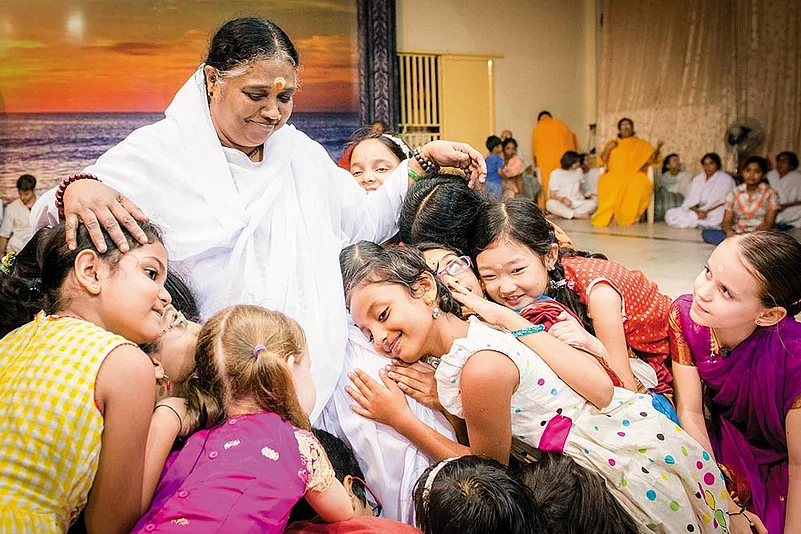
Amma says her dharma is to be everyone’s mother
Do you seek to intervene in politics? Are you close to the Sangh parivar or the BJP?
Politics is neither my path nor my dharma. But people from all political parties and all walks of life come to see me—not just from the BJP. The Congress leader and the Communist, the atheist and the rationalist, the management and the labourer—all come to see me. But nobody has ever asked whether I am close to the Congress or have ties with the Communists. I do not understand why journalists always ask whether Amma is connected to the RSS or the BJP. My path is to accept everyone; it is my dharma to be a mother to everyone. Hence, I cannot define such boundaries anywhere. I have to flow like the river, and that is what I do.
You run many educational institutions. Today, don’t we see an education system here that alienates our children from their own place, time and culture, especially their native language? You described many rural traditions from your childhood that today’s children, even in this same area of Kollam, may not be able to identify with.
An education system that does not give importance to one’s native language and spiritual principles is equal to separating a child from its mother. Such an education will breed many unhealthy habits and create severe handicaps for our students. Our youth are very intelligent and talented, but their emotional maturity is quite poor. Even trivial things incite them. They exhibit no love, gratitude or respect for their parents, teachers or elders. Contempt and arrogance are becoming their hallmarks. Our youth are proceeding to a dangerous state.
Education should start with the mother, the role model in the family. What the mother exemplifies is reflected in the children. When both parents go to work, no one is home to be a role model. In today’s world, the grandmother is also not there to provide this. Children are sent to hostels, where they compete with each other to show off who has the best clothes and so on. Children from poor economic backgrounds feel inferior and then pressure their parent to buy those things for them, which they cannot afford. The children then resort to stealing and other means to fulfil their desires. Children are not getting values and role-models from their homes.
Why are you giving so much attention to the education sector?
I give attention to other fields as well. Take women’s empowerment, for example. Two lakh women have been empowered through our AmritaSREE (Amrita Self-Reliance, Education and Employment) programme—whether that is through vocational training, guiding them to get loans or providing them with clothing. Other examples are building homes for homeless, care for the elderly, education for the differently-abled, water distribution, rural village adoption, providing solar lighting in our adopted villages, providing water and water-distribution networks, teaching rural children through tablets, pre-natal and pregnancy-care awareness, health camps, medical awareness. Rural people are taught about basic medical care, grooming and hygiene. In this village, in the olden days, even with toilets in their homes, the children would defecate on the beach. I also grew up like that. Recently a journalist asked me, “What is the point of building toilets for these people? Will they be able to change their habits?” I replied, “I myself am proof that they can change.” We taught women how to construct toilets. Similarly there are hundreds of other things. Education is just one among them.
Is celibacy important for spirituality? Aren’t relationships and sex important for a person’s self-realisation?
In all areas and paths of life there are some disciplines and codes of conduct that have to be followed. Isn’t everyone bound by certain rules? Self-realisation is a journey to inner freedom. The most important factor in the monastic path is mental restraint. Celibacy is a part of that restraint. It doesn’t just mean restraint of sexual instincts. Its intention is to mentally distance the spiritual aspirant from everything that may cause distraction from the spiritual goal. People who wish to follow a strict spiritual path should be careful not to get physically close or become attached to the opposite sex. Once they have gained the ability to overcome temptation and weakness, then such interactions cease to be a problem. However, family life is never an impediment for spiritual life. Those who have worldly desires can travel along the spiritual path while leading a family life. But even on that path, one should progressively practise mental restraint. Many of our ancient sages had families.
What sort of people do you accept as ashram inmates? Do you see anything special in a potential spiritual recruit?
As far as I am concerned, each person is special and has the divine spark within. The most important quality of a spiritual aspirant is an ardent desire to know oneself and to serve others selflessly. I never select anyone in particular or force anyone to stay in the ashram. It is impossible to bring anyone to the path of spiritual quest forcibly. It is an inner calling.
From Vatican to Africa, there are Malayali Catholic priests and nuns all over the world, as also Anglican priests. Now, Malayali Muslims go to Syria to join the Islamic State. And from Adi Shankara to you, there is no dearth of Malayali Hindu spiritual icons. Why is Kerala such a fertile ground for spirituality?
India is the land of spirituality. Not only in Kerala, but in every nook and corner of India, there have been spiritual masters. But there is one thing that needs to be pointed out: There is no place for terrorism in spirituality, nor any place for spirituality in terrorism.
Was there a specific turning point in your childhood when you decided to become a spiritual guide?
I don’t feel there was any specific turning point. I am the same then and now. I was doing it from my childhood. There was no particular turning point. Seeing the lives of the deprived, I wanted to understand the reason for the suffering and to find a practical solution that could bring them relief. That is all.
What is special about meditation?
All that you see here shows what is special about meditation. It helps one gain peace of mind. That is why they can do so much nishkama seva—selfless service—in the institutions. Meditation makes all their actions sweet; every aspect of service is sweet. Meditation is like gold with fragrance. Imagine how precious such gold would be!
What is your outlook on politics?
People come here and go, but I do not pay attention to these things.
I don’t mean party politics; only your general political perspective. For example, a monk has become a chief minister. Should spiritual leaders become politicians?
In reality, if he is ruling with the dharmic values, then it is okay. If the sannyasi is a person who knows spirituality, he will rule without caste and religious discrimination, with the ideal of loving and serving everyone. In the olden days, Rama and Krishna ruled kingdoms in a dharmic way. Sita’s father, Janaka, was a realised soul and a ruler. Such people will be firmly rooted in dharma. Ultimately, each person is free to decide what and who he should be.
I don’t have any interest in politics. I give love to everyone who comes here and serve them. Righteousness should prevail. This is my wish; that’s all. The universe itself is sustained by dharma. Humankind has been disregarding it and we are now seeing the repercussions.
There were two controversies surrounding the ashram—Gail Tredwell and Satnam Singh. What is the truth about these allegations?
These allegations are completely unfounded. With regard to that son (Satnam Singh), I am deeply pained at his death. When I think of his parents and relations, I feel sad. But no one here ever did anything to him. One day when I was giving darshan, he ran up the ramp to the stage, loudly yelling some mantras. There is a video of him jumping on the ramp in just his underwear and running up to the stage yelling some mantra loudly. Seeing him rushing towards me, some of the ashram residents created a protective chain around me. The police then took him away. The ashram residents never did anything to him. His own brother saw him at the Karunagappally Police Station and told the newspapers and TV media, “There was not a single mark on his body in the jail.” Then we do not know what happened.
That daughter (Gail Tredwell) made up a story based on something in her imagination. Anyway, I feel no anger towards her. I have only love for her and pray for her. She fell in love with someone; that is why she left the ashram. Otherwise, she would not have left. That didn’t work out and she married someone else. Then she left him also. After all that, she wrote the book. But I do not worry about such false allegations. From a young age, I have heard such things. I have had to face many troubles following this dharma as a woman. The villagers who threw stones back then now shower me with flowers.
No spiritual person has ever made his or her home an ashram. Usually such people are driven away from their native place. But at least these villagers were better than that; they did not drive me away. This is the house I was born in. The house in which my mother gave birth to me is still standing. So, having grown up here, I have heard several false allegations. I accept them all.
In south Travancore, from Kanyakumari onwards to Kollam up until Chavara, there has been conversion to Christianity along the coastline. Why hasn’t there been so much conversion in this area alone?
In Kanyakumari, they converted all those people. Then all of Kollam and Thiruvananthapuram. Then, up until Chavara. That happened back in my father’s time. In truth, the spiritual leaders should have protected them by imparting proper awareness about Sanatana Dharma. Only in this area, there is not that much conversion.
Is there any particular reason for that?
That’s because the people who belonged to this area were strongly connected with certain traditions, religious etiquettes and the temples here. Every harbour here had around 300 houses and one temple. Again, another 500 houses and then a temple. And so on.
On my way here, I passed at least three big temples.
They are going to build another bigger temple soon. These people here still adhere to the ancient culture. If a boat comes ashore with fish worth Rs 100, they put aside Rs 10- to Rs 20-worth of their catch. If they get fish worth Rs 1,000, they put aside Rs 100-worth. Then they distribute it free, no matter how many people come. Out of that, they give a certain percentage to the temple—two per cent. This is done whether they fish from boats or from small canoes. When it is divided, only 35 per cent is taken by the owner of the boat and with this he has to pay for all the diesel and maintenance. After that is taken, the rest is divided equally; they are not paid daily wages. This tradition is followed even today.
If a wedding happens, each person gives Rs 1,000-2,000 as his contribution—sometimes even up to Rs 5,000. They don’t have the system of interest. They return it at the time of the other person’s wedding. That is how they get gold ornaments. They never had bank accounts. Now they do, but not in olden times. Instead, they would buy bronze vessels. Then, when their income was low, like during the monsoon, they would sell the vessels for survival. They do not have much, but they have unity. There is a great unity among families and within the society. This is exemplary: this give and take during weddings and so on. But the temples came first and foremost. In this area, there is more temple worship. Maybe that is why conversion did not happen too much here. On the Azhikkal side, people were converted more—about 200 houses. At first a few houses, then more and more. But, here, because of the unity among families, it did not happen much.







